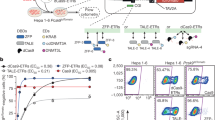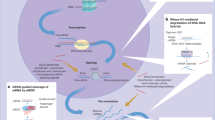Abstract
Transcription factor E2F plays a pivotal role in the transactivation of cell cycle regulatory genes, leading to vascular lesion formation. Double-stranded DNA with high affinity for E2F as ‘decoy’ cis elements may block the activation of genes mediating the cell cycle, resulting in an effective therapeutic agent for treating intimal hyperplasia. In this study, we tested the feasibility of E2F decoy therapy to treat neointimal formation in a porcine coronary artery balloon injury model. An angioplasty catheter was inserted in the left anterior descending coronary artery of pigs to cause vascular injury. Initially, we tested the feasibility of transfection of FITC-labeled E2F decoy ODN using a hydrogel balloon catheter. Fluorescence due to E2F decoy ODN could be detected throughout the medial layer. Therefore, we transfected E2F decoy ODN into the balloon-injured artery using hydrogel catheter. Of importance, intravascular ultrasound (IVUS) and histological evaluation demonstrated that plaque area in the balloon-injured artery was significantly reduced by E2F decoy ODN compared with mismatched decoy ODN at 1 month after a single transfection (P < 0.01). In contrast, luminal and total vessel areas were significantly increased in vessels treated with E2F decoy ODN as compared with mismatched decoy. Endothelial function after angioplasty was not affected by E2F decoy transfection. Finally, we tested the acute toxicity of E2F decoy ODN in monkeys, and no apparent side-effects were detected. Here, we report the successful in vivo transfer of E2F decoy ODN using a hydrogel catheter to inhibit vascular lesion formation in balloon-injured porcine coronary artery without any apparent side-effects.
This is a preview of subscription content, access via your institution
Access options
Subscribe to this journal
Receive 12 print issues and online access
$259.00 per year
only $21.58 per issue
Buy this article
- Purchase on Springer Link
- Instant access to full article PDF
Prices may be subject to local taxes which are calculated during checkout








Similar content being viewed by others
References
Gibbons G.H., Dzau V.J. . The emerging concept of vascular remodeling N Engl J Med 1994 330: 1431 1431
Weintraub S.J., Prater C.A., Dean D.C. . Retinoblastoma protein switches the E2F site from positive to negative element Nature 1992 358: 259 259
Pagano M., Draetta G., Durr J. . Association of cdk 2 kinase with the transcription factor E2F during S phase Science 1992 255: 1144 1144
Morishita R., Higaki J., Tomita N., Ogihara T. . Application of transcription factor ‘decoy’ strategy as means of gene therapy and study of gene expression in cardiovascular disease Circ Res 1998 82: 1023 1023
Mann M.J., Dzau V.J. . Therapeutic applications of transcription factor decoy oligonucleotides J Clin Invest 2000 106: 1071 1071
Morishita R. et al. A novel molecular strategy using cis element ‘decoy’ of E2F binding site inhibits smooth muscle proliferation in vivo Proc Natl Acad Sci USA 1995 92: 5855 5855
Tomita N. et al. An oligonucleotide decoy for transcription factor E2F inhibits mesangial cell proliferation in vitro Am J Physiol 1998 275: F278 F278
Ehsan A., Mann M.J., Dell'Acqua G., Dzau V.J. . Long-term stabilization of vein graft wall architecture and prolonged resistance to experimental atherosclerosis after E2F decoy oligonucleotide gene therapy J Thorac Cardiovasc Surg 2001 121: 714 714
Mann M.J. et al. Ex vivo gene therapy of human vascular bypass grafts with E2F decoy: the PREVENT single-centre, randomised, controlled trial Lancet 1999 354: 1493 1493
Post M.J. et al. Arterial remodeling after balloon angioplasty or stenting in an atherosclerotic experimental model Circulation 1997 96: 996 996
de Smet B.J. et al. The atherosclerotic Yucatan animal model to study the arterial response after balloon angioplasty: the natural history of remodeling Cardiovasc Res 1998 39: 224 224
Asahara T. et al. Local delivery of vascular endothelial growth factor accelerates reendothelialization and attenuates intimal hyperplasia in balloon-injured rat carotid artery Circulation 1995 91: 2793 2793
Hayashi K. et al. In vivo transfer of human hepatocyte growth factor gene accelerates re-endothelialization and inhibits neointimal formation after balloon injury in rat model Gene Therapy 2000 7: 1664 1664
Morishita R. et al. In vivo transfection of cis element ‘decoy’ against NFkB binding site prevented myocardial infarction as gene therapy Nat Med 1997 3: 894 894
Ohno T. et al. Gene therapy for vascular smooth muscle cell proliferation after arterial injury Science 1994 265: 781 781
Gunn J. et al. The effect of oligonucleotides to c-myb on vascular smooth muscle cell proliferation and neointima formation after porcine coronary angioplasty Circ Res 1997 80: 520 520
Simon A.D. et al. Porous balloon delivery of S-dC28 does not prevent restenosis in the porcine coronary artery model of balloon injury Antisense Nucleic Acid Drug Dev 1999 9: 549 549
McKay R.G. . Hydrogel-coated balloon catheter Semin Interv Cardiol 1996 1: 45 45
Palasis M., Luo Z., Barry J.J., Walsh K. . Analysis of adenoviral transport mechanisms in the vessel wall and optimization of gene transfer using local delivery catheters Hum Gene Ther 2000 11: 237 237
Isner J.M. et al. Arterial gene transfer for therapeutic angiogenesis in patients with peripheral artery disease Hum Gene Ther 1996 7: 959 959
Isner J.M. . Arterial gene transfer of naked DNA for therapeutic angiogenesis: early clinical results Adv Drug Deliv Rev 1998 30: 185 185
Khaled Z., Benimetskaya L., Zeltser R., Khan T., Sharma H.W., Narayanan R., Stein C.A. . Multiple mechanisms may contribute to the cellular anti-adhesive effects of phosphorothioate oligodeoxynucleotides Nucleic Acids Res 1996 24: 737 737
Srinivasan S.K., Iversen P. . Review of in vivo pharmacokinetics and toxicology of phosphorothioate oligonucleotides J Clin Lab Anal 1996 9: 129 129
Henry S.P., Bolte H., Auletta C., Kornbrust D.J. . Evaluation of the toxicity of ISIS 2302, a phosphorothioate oligonucleotide, in a four-week study in cynomolgus monkeys Toxicology 1997 120: 145 145
Cornish K.G. et al. Cardiovascular effects of a phosphorothioate oligonucleotide with sequence antisense to p53 in the conscious rhesus monkey Pharmacol Commun 1993 3: 239 239
Henry S.P. et al. Activation of the alternative pathway of complement by a phosphorothioate oligonucleotide: potential mechanism of action J Pharmacol Exp Ther 1997 281: 810 810
Roque F. et al. Safety of intracoronary administration of c-myc antisense oligomers after percutaneous transluminal coronary angioplasty (PTCA) Antisense Nucleic Acid Drug Dev 2001 11: 99 99
Morishita R. et al. Intimal hyperplasia after vascular injury is inhibited by antisense cdk 2 kinase oligonucleotides J Clin Invest 1994 93: 1458 1458
Ge J. et al. Intravascular ultrasound imaging of arterial wall architecture Echocardiography 1992 9: 475 475
Matsumoto K. et al. Inhibition of neointima by ACE inhibitor in porcine coronary artery balloon injury model Hypertension 2001 37: 270 270
Acknowledgements
This work was partially supported by a grant from the Japan Health Sciences Foundation, a Grant-in-Aid from the Ministry of Public Health and Welfare, a Grant-in-Aid for the Development of Innovative Technology, a Grant-in-Aid from Japan Promotion of Science, and Special Coordination Funds of the Ministry of Education, Culture, Sports, Science and Technology, the Japanese Government.
Author information
Authors and Affiliations
Rights and permissions
About this article
Cite this article
Nakamura, T., Morishita, R., Asai, T. et al. Molecular strategy using cis-element ‘decoy’ of E2F binding site inhibits neointimal formation in porcine balloon-injured coronary artery model. Gene Ther 9, 488–494 (2002). https://doi.org/10.1038/sj.gt.3301679
Received:
Accepted:
Published:
Issue Date:
DOI: https://doi.org/10.1038/sj.gt.3301679
Keywords
This article is cited by
-
Downregulation of TNF-α and VEGF expression by Sp1 decoy oligodeoxynucleotides in mouse melanoma tumor
Gene Therapy (2003)
-
Post-intervention vessel remodeling
Gene Therapy (2002)



